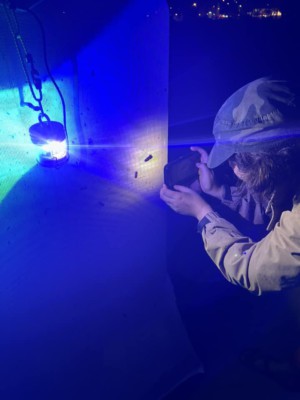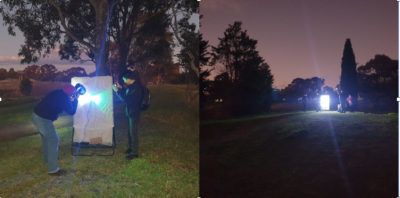
FLY BY NIGHT
Active and events held monthly when there is no moon.
Fly By Night report 2022
Pascale Jacq and Dassi Herszberg
All components of our equipment used are working well, and charging units last the duration of each session (Over 6 hours). We are still ironing out best way of hanging the lantern; we trial different methods each time, eg -. Hanging from frame, hanging from string adjacent to screen, in order for the best light reflection on the sheet. Regardless, many insects and spiders are attracted to our stations, showing the light is bright enough for our surveys
Success of project: We have not gathered enough data in these 4 sessions to make an informed evaluation or outcome. Invertebrates are only now emerging in warmer weather. Twice we had to cancel/postpone due to rainy and windy weather. On our first survey the iNaturalist.com citizen science platform was down for 3 days so we struggled to upload our observations.


Our first survey on 27th August 2022 resulted in 126 species being observed, including 30 spiders, 26 moths/butterflies, 10 wasp/ant/bees, 10 beetles.
Our 2nd survey on 24th September (Grand Final Day and also a clash with Vic. Entomological Society meet up) resulted in 11 species being observed and uploaded onto iNaturalist, including 7 moths, 2 spiders and 1 fly. (I suspect more were observed on the night but have yet to be added to our iNaturalist project.)
Our 3rd Survey on 22nd October was postponed a week due to weather and slippery conditions, but some Entomological Society members went ahead anyway at Stations #1 and #2 with their own equipment. Despite drizzle and a bit of wind, 76 species were observed, including 40 moths, 2 spiders, 5 beetles and 3 flies.
Our 4th survey on 29th October was drizzly and cold and was a clash with some events the Entomological Society were running that long weekend (Melbourne Cup Weekend). In the end only 3 people showed up so we put up Station #1, and found 2 spiders, 3 flies, 3 moths and a wasp and an ant.
The communication with members of the Entomological Society of Victoria is wonderful and has increased our participation rates as they have advertised our Fly By Night dates in the Victorian Entomologist news bulletin. Volume 52 (#5, October 2022) had an article about our project on page 98 , written by member Daniel Kurek (a regular participant and core member of our project).
We have agreed on a minimum of 2 participants always present at each station. If less (some participants need to leave etc.), the station is packed up and moved to the nearest other station.
Our plan is to run a minimum of 2 stations every month. As the weather heads into Spring and Summer and grasses and flowers are seeding and blooming in the Yalukit Willam Reserve, we anticipate many more invertebrate observations.
To view our current invertebrate biodiversity -have a look at the YWNR iNaturalist project here
HistoricalBaseline Surveys
EPNR fauna survey
The EPNR fauna survey is being conducted, in order to have baseline data in relation to biodiversity, by which the success of the EPNR development can be measured.
It includes studies of birdlife, nocturnal fauna, microbats, nocturnal invertebrate as well as aquatic macroinvertebrate surveys.
The survey started in May 2019 and continued through to March 2020.The final parts of the survey will be collected and written up over 2022. The survey was interrupted by the many lockdowns over the last two years.
The volunteer input into this survey has been tremendous, with roughly 550 volunteer hours involved. This is simply a measure of formal, timed, volunteer hours and does not include study design, coordination or write up.
Organisation involved in the survey include:
- Yalukit Willam Nature Association
- Bayside City Council
- Birdlife Australia
- Wildlife Victoria
- Waterwatch arm of Friends of Elster Creek
The results of this survey, point to a high level of baseline biodiversity in the Elsternwick Park Nature Reserve, as well as a number of challenges to this biodiversity, namely pest species, dogs of leash, heat stress, as well as interruption of environmental flow.
Bird Survey
The bird survey is being led by Tania Ireton from Birdlife Bayside. It began in May 2019 and continued until March 2020. In total 11 months of data has been collected. Interim results show 48 species identified. The monthly species range identified 22 to 28, the median 26.
The 8 most abundant native bird species identified are:
- Rainbow Lorikeet
- Musk Lorikeet
- Australian Magpie
- Little Raven
- Magpie Lark
- Welcome Swallow
- Crested Pigeon
- Red Wattle Bird
Rarer bird species are also resident in the reserve in smaller numbers and include:
- The Great Egret – this threatened species is resident in the reserve throughout the cooler months
- White Faced Heron – a breeding pair are resident in the reserve
- Eastern Rosella – a small, breeding flock are resident in the reserve
- Tawny Frog Mouth – a breeding pair are resident within the reserve
- Australian Reed Warbler-a pair were, for the first time, seen to breed in the reserve this summer
- Little Raven
- Tawny Frogmouth parent and chick
Notable visitors to the reserve included:
- A flock of Gang-gang Cockatoos
- A flock of Yellow-tailed Black Cockatoos
- White-winged Trillers
- Royal Spoonbill
- Common Bronze Wing
Of note, visitors were almost invariably harassed and attacked by noisy minors. One of the white winged trillers was seen being attacked by noisy minors and was later, found dead with multiple head wounds, likely due to noisy minor attack.
The most common pest bird species identified are:
- Noisy Miner -this was the most common bird in the reserve and the most aggressive.
- Rock Dove (generally seen in Area G, along the canal).
- Evidence of breeding success was observed during the survey, as well as a number of challenges. Highlights in breeding success included:
- Eastern Rosella chicks being bred in artificial log hollows and making it through to maturity
- A number of other species of native birds including Purple Swamphens, Grey Butcherbirds, a Tawny Frogmouth chick and a White-faced Heron chick making it through to maturity.
Challenges included death of juveniles via dog attack as well as other losses of juveniles, presumably from fox or cat predation (see wildlife camera study).
Dogs on vs off lead were studied during this survey, the overall ratio was 5:1 five dogs on lead for every one dog off lead (Number of dogs on lead = 109 off lead = 26). These ratios varied over time and appeared to be most influenced by the presence of signage in the reserve.
YWNA holds a Bird Survey every month- check events.
Night Surveys
We began our night surveys in May 2019 and ended in February 2020 due to Covid-19, 10 months in total.
Several major highlights being:
- Positive sightings of Rakali in the small wetland lake
- Identification of several micro-bat species such as the Gould Wattled and Little Forest Bat
- Juvenile Eastern Rosella in flight
- Large numbers of Grey-headed Flying- observed flying over the park with around 74 identified in January
- More Ringtail Possums than Brushtail Possums identified
- Galaxias outnumber Gambusia by a 6 to 1 ratio
- Fish counts dropped radically, coincident with cessation of environmental flows.
- Long-necked Turtle rescued from a drain and release into the wetland lake
- Nankeen Night Heron and Great Egret both identified on 3 occasions
- Tawny Frogmouth observed hunting
- Southern Brown Tree Frogs both heard and seen in area G, along Elster creek.
- A variety of insects and arachnids identified
Microbat Survey
This extensive survey is underway, under the supervision of Dr Lindy Lumsden, Victoria’s leading bat expert. There have been four species of microbat identified within the reserve, namely:
- Gould’s Wattled Bat
- Little Forest Bat
- Long-eared Bat (likely Lesser Long-eared as most common in Melbourne but impossible to tell for certain, just from call)
- White-striped Freetail Bat.
Wildlife Necropsy Study
This study is being led by Wildlife Victoria vets, Tim White and Sara Orphin. To date there have been five dead wildlife specimens that have been able to be examined. Species have included brushtail and ringtail possums (one with three young in pouch), juvenile purple swamp hens and a white winged triller. The most common likely cause of death was dog attack. Other causes of death including likely hyperthermia, noisy minor and fox attack.
The key suspected limitation of this study is the known fact that cats will take their prey away from the site of attack, so that death via cat predation will not be included in these studies. It is known that cats are active in the reserve (see below) and we have no data on their impact on wildlife.
Night Wildlife Camera Survey
Night cameras placed in the park have shown cat, fox and black rat activity in the early hours of the morning.
Nocturnal Invertebrate Study/Fly by Night
We have engaged experienced entomologist Peter Marriott and keen amateur entomologists Anthony , Daniel and Ben Kurek who are all part of the Victorian Entomological Society to join and train our team until we get equipment and experience. We have run 5 sessions for our baseline study over 12 months. The study continued into the early Spring of 2022. There is now an iNaturalist project set up so that anyone can add their observations to it at any time or have a look at the page to see the incredible biodiversity often hiding in plain sight.Aquatic Macro-invertebrate Surveys
The Waterwatch arm of Friends of Elster creek has been conducting quarterly surveys of aquatic invertebrates in the EPNR wetlands.
Here is a link to a very helpful Waterbug Taxonomy kit that we are using in the field.
You can view some of the results that are on the Melbourne Water Waterwatch site.
Weed seed Case Study
Method outline: By incorporating a regime of direct sowing into the act of hand-weeding; the YWNA aims to develop the ecological advantages typical of a remnant site. This works by transforming the soil seed-bank from one dominated by non-native species to one dominated by natives. When semi-mature herbaceous weeds are pulled out before they set their own seed, the patches of bare, friable soil le> in their wake offer ideal conditions for the germination of many seeds. It is into this environment that native seeds will be sown on a cyclical basis.
Benefits: Not only will this practice simultaneously enhance native plant diversity while reducing long-term weed invasion prospects and ecological damage associated with chemical-based weed management, it will also diversify habitats available to fauna by partially reinstating the cycles of disturbance and succession so essential to biodiversity but so lacking in typical revegetation sites.

